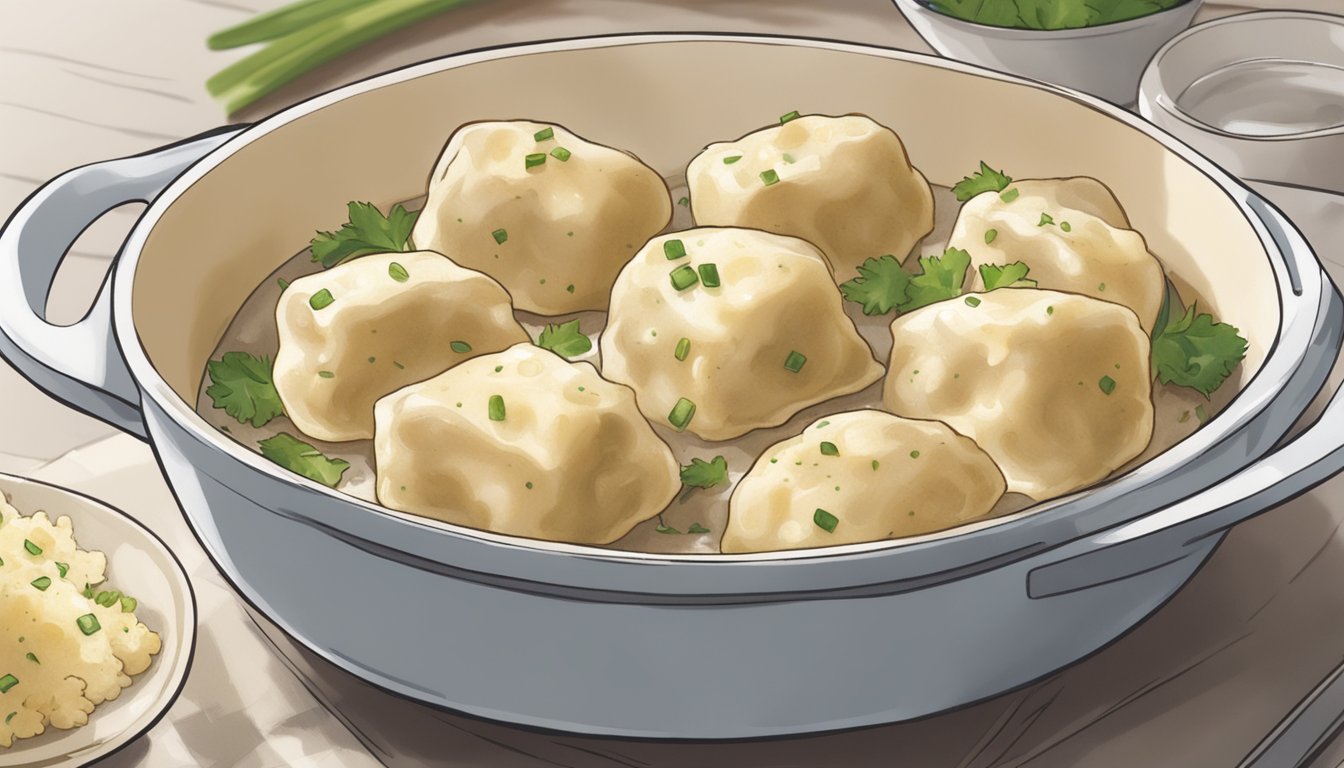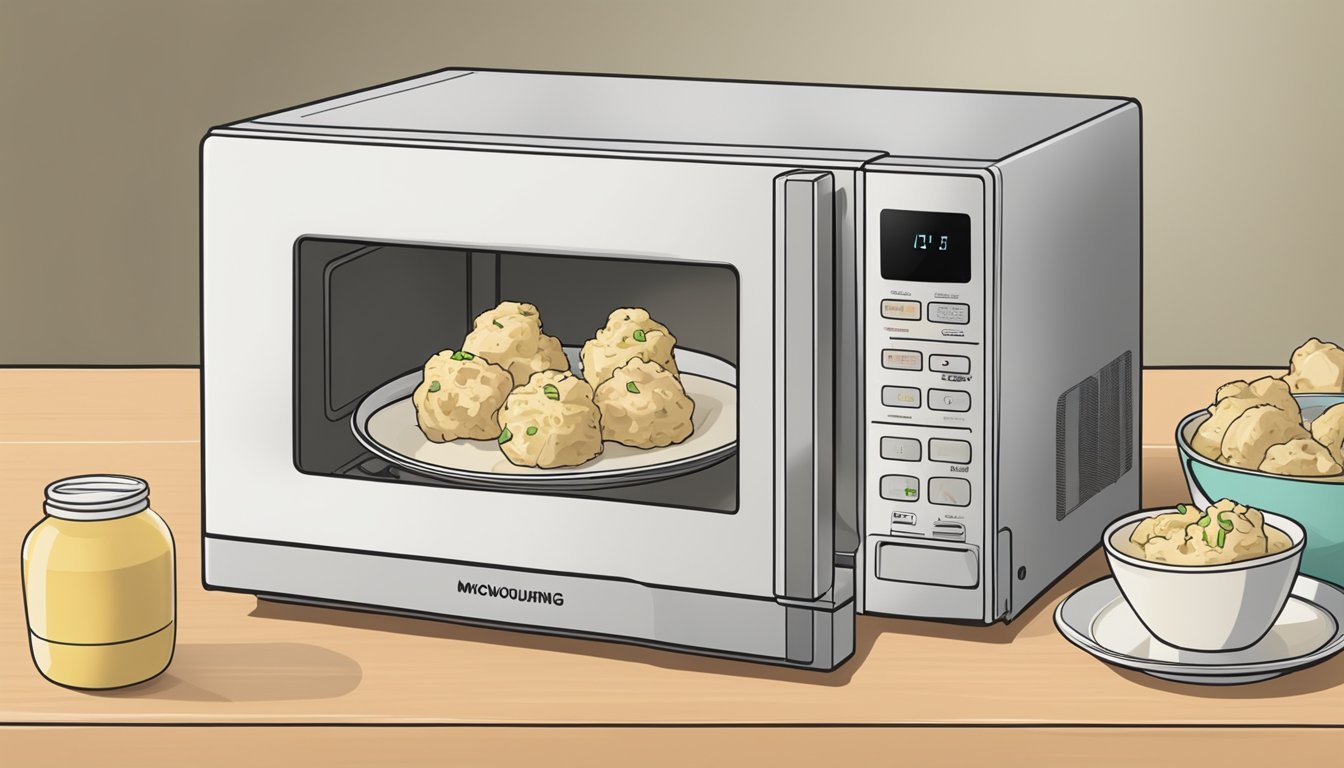How to Reheat Chicken and Dumplings Bites
Best Methods and Tips
Bringing back the comforting flavors of chicken and dumplings doesn't have to be a challenge. To expertly reheat chicken and dumplings bites, ensuring they remain as delightful as when freshly made, follow reliable methods like oven or stovetop reheating. These techniques preserve both the texture and taste, making your leftovers just as satisfying as the original meal.
For those who prefer the oven method, preheat it to 350 degrees Fahrenheit and place the bites in an oven-safe dish, adding a small amount of broth or water to prevent drying out. Cover the dish with aluminum foil and bake for 15-20 minutes until heated through. This method helps maintain the quality of the dumplings and chicken.
For a quicker option, reheating on the stove involves simmering the bites on low heat for 10-15 minutes. Stir occasionally to prevent sticking and ensure even heating throughout. This gentle reheating helps meld the flavors together again, providing a comforting meal experience.
Understanding Chicken and Dumplings
Chicken and dumplings is a hearty dish known for its comforting texture and rich flavor. The texture, especially of the dumplings, plays a crucial role, as does the variety of dumplings used, which can vary significantly between different cuisines.
Significance of Texture and Flavor
Texture is pivotal in chicken and dumplings. The chicken should be tender and moist, while the dumplings must strike a balance between being light and slightly chewy. Too dense dumplings can make the dish heavy, while overly light ones might disintegrate. The flavors should meld well; savory chicken broth often complements the soft, doughy dumplings, creating a well-rounded taste experience.
Maintaining this balance during reheating is important. It prevents the dish from becoming either too soggy or too dry. Proper reheating techniques, such as using broth or water, help in preserving the texture and flavor.
Overview of Types of Dumplings
Dumplings vary widely across different cuisines, impacting the texture and taste of chicken and dumplings. In American cuisine, the most common types are drop dumplings and rolled dumplings. Drop dumplings are spooned directly into the broth, resulting in a fluffy texture. Rolled dumplings are flattened and cut into strips, providing a denser bite.
Other cuisines might incorporate ingredients like herbs or spices into their dumplings for additional flavor. Understanding these differences ensures the dish maintains its intended character, no matter the type of dumplings used. This knowledge is crucial for both preparing and reheating chicken and dumplings effectively.
Proper Storage Techniques
Proper storage is essential to maintain the quality and safety of chicken and dumpling bites. This involves using the right methods for both refrigerator and freezer storage to keep the food fresh and delicious.
Refrigerator Storage
Chicken and dumpling bites should be stored in airtight containers to prevent contamination and maintain moisture. Refrigerating the bites within two hours of cooking is crucial to avoid bacterial growth. Use containers with tight-fitting lids or high-quality Ziploc bags to ensure no air gets in.
Label the containers or bags with the date of storage to keep track of freshness. Stored correctly, chicken and dumpling bites can be refrigerated safely for up to 3-4 days. Always check for any signs of spoilage, such as an off smell or change in texture, before reheating.
Freezer Storage
For longer storage, freezing is an effective method to preserve chicken and dumpling bites. Begin by placing the bites in airtight containers or heavy-duty freezer bags. Remove as much air as possible to prevent freezer burn, which can affect taste and texture.
Label the containers or bags with the date of freezing. Properly stored, chicken and dumpling bites can remain safe and maintain quality in the freezer for up to 3 months. Before reheating, thaw the bites in the refrigerator overnight for even heating.
Use durable containers or vacuum-sealed bags to minimize exposure to air and moisture, ensuring the bites stay fresh and tasty.
Preparation for Reheating
Proper preparation is key to ensuring reheated chicken and dumplings bites are both flavorful and moist. To achieve the best results, focus on two main aspects: bringing the leftovers to room temperature and adding extra moisture.
Bringing to Room Temperature
Before reheating, let the chicken and dumplings sit at room temperature for about 20-30 minutes. This step helps to ensure even reheating. Quickly reheating cold food can lead to uneven heating, where the outside becomes too hot while the inside remains cold.
Using this technique can significantly reduce the time required to reheat and enhance the texture. Place the leftovers on a plate or in their reheating dish and allow them to come to room temperature naturally. Avoid using heat sources to speed up this process, as it might start cooking the food prematurely.
Adding Moisture
Reheating chicken and dumplings can dry them out if additional moisture isn't added. To counteract this, incorporate a small amount of liquid such as water, broth, or even a light sauce. For stovetop reheating, pour a few tablespoons of broth into the pan before adding the chicken and dumplings. This not only prevents sticking but also keeps the bites moist.
Another method involves sprinkling water over the dish if reheating in the microwave, and then covering it with a microwave-safe lid or plastic wrap to trap the steam. When using the oven, consider adding a bit of broth or water to the dish and covering it with aluminum foil to prevent moisture loss.
Reheating Methods
Reheating chicken and dumplings bites can be done effectively using several methods. Each method has its own advantages and specific steps to ensure they remain moist and flavorful.
Microwave Method
The microwave offers a quick and easy way to reheat chicken and dumplings bites. Begin by placing the bites in a microwave-safe dish, ensuring they are spread out evenly. Add a small amount of broth or water to maintain moisture.
Cover the dish with a microwave-safe lid or wrap. Heat on medium to high for 2-3 minutes, stirring or flipping halfway through. Check the temperature; they should reach an internal temperature of 165°F. For thicker pieces, additional heating time may be needed.
Oven Method
The oven method ensures even heating and is best for larger portions. Preheat the oven to 350°F. Place the chicken and dumplings bites in an oven-safe dish, adding a bit of broth or water.
Cover the dish with aluminum foil to keep the moisture in. Heat for 20-25 minutes, checking to ensure they are thoroughly warmed to an internal temperature of 165°F. This method takes longer but delivers consistent results.
Stovetop Method
Reheating on the stovetop preserves texture and flavor. Use a skillet over medium heat and add a small amount of water or broth. Once the liquid simmers, add the chicken and dumplings bites.
Cover with a lid, leaving it slightly ajar to allow steam to escape. Stir occasionally to avoid sticking and ensure even heating. In about 10-15 minutes, the bites should be hot throughout.
Air Fryer Method
For crispy results, the air fryer is ideal. Preheat the air fryer to 360°F. Place the chicken and dumplings bites in a single layer in the basket.
Spritz them with a light coating of nonstick spray. Heat for 5-7 minutes, shaking the basket halfway through. Ensure they reach an internal temperature of 165°F. The air fryer offers a quick and even reheating method that keeps bites crispy.
Ensuring Safety and Quality
Reheating chicken and dumplings bites requires careful attention to food safety, moisture retention, and even heating. Achieving the right internal temperature while preventing the bites from drying out ensures both safety and quality.
Internal Temperature
Chicken and dumplings bites should be thoroughly reheated to ensure safety. The ideal internal temperature for reheated chicken is 165°F (74°C).
A food thermometer is the most accurate tool to check this. Insert the thermometer into the thickest part of the bites to get an accurate reading.
Ensure that multiple bites reach this temperature to guarantee they are heated evenly. If using an oven or air fryer, preheat to about 350°F (175°C), and check the food halfway through the reheating time.
Preventing Drying Out
To maintain the moist texture of chicken and dumplings bites, it’s essential to use a bit of liquid during reheating. Adding broth or water to the reheating dish can help.
Covering the dish with aluminum foil traps steam, keeping the bites from drying out. For microwaving, a microwave-safe lid or plastic wrap serves the same purpose.
Stir occasionally if using a stovetop method, to ensure even
Special Considerations for Reheating Dumplings
Different methods for reheating dumplings can significantly impact the texture and flavor. Whether you prefer them in soup or with a crispy exterior, choosing the right technique is essential.
Reheating Soup or Sauce-Based Dumplings
When reheating dumplings served in soup or sauce, maintaining moisture is crucial. Begin by placing the dumplings and their broth or sauce in a pot.
Heat over low to medium heat, stirring gently to prevent sticking and ensure even warming. Cover the pot, leaving a slight opening to allow steam to escape. Simmer for about 10-15 minutes. Adding a bit of extra broth or water will help maintain the dish's moisture, ensuring the dumplings remain tender.
If microwaving, use a microwave-safe bowl and cover with a damp paper towel. Heat on medium power in one-minute intervals, stirring in between, until thoroughly warmed.
Handling Crispy or Fried Dumplings
For crispy dumplings like gyoza or potstickers, reheating methods should preserve their crunch.
Preheat a pan over medium heat and add a small amount of oil. Place the dumplings in the pan, ensuring they are not crowded. Fry them for 2-3 minutes until the bottoms are crispy. Add a small amount of water to the pan, cover immediately, and steam for another 2-3 minutes.
Alternatively, preheat an oven to 350°F. Place the dumplings on an oven-safe dish and cover with foil to prevent drying out. Heat for 10-15 minutes or until crispy and warm. Avoid microwaving, as this will likely make the dumplings soggy.
By following these steps, reheating ensures the texture and flavor of the dumplings are preserved.
Tips for Enhancing Reheated Chicken and Dumplings
Incorporating fresh ingredients and optimizing leftovers can significantly improve the flavor and texture of reheated chicken and dumplings.
Adding Fresh Herbs and Vegetables
Fresh herbs like parsley, thyme, and dill can reinvigorate reheated chicken and dumplings. Chopping these herbs and sprinkling them over the dish just before serving adds a burst of freshness and complexity.
Including fresh vegetables is another excellent way to enhance the meal. Consider adding peas, carrots, or green beans. These can be quickly sautéed or steamed and mixed into the dish. Extra vegetables not only improve the flavor but also add nutritional value, making the meal more balanced.
Optimizing Leftover Dumplings
To avoid soggy or rubbery textures, it's essential to reheat dumplings properly. One method is to steam them separately from the chicken. Using a steamer basket or microwave steamer, heat the dumplings until they're warm but not overcooked.
If the dumplings are baked or fried rather than boiled, reheat them in the oven to maintain their texture. Place them on a baking sheet at 350°F for about 10-15 minutes. Adding a bit of broth or water to the sheet helps keep them moist and prevents drying out.
By following these tips, leftover dumplings can retain their original appeal and blend seamlessly with the reheated chicken.






